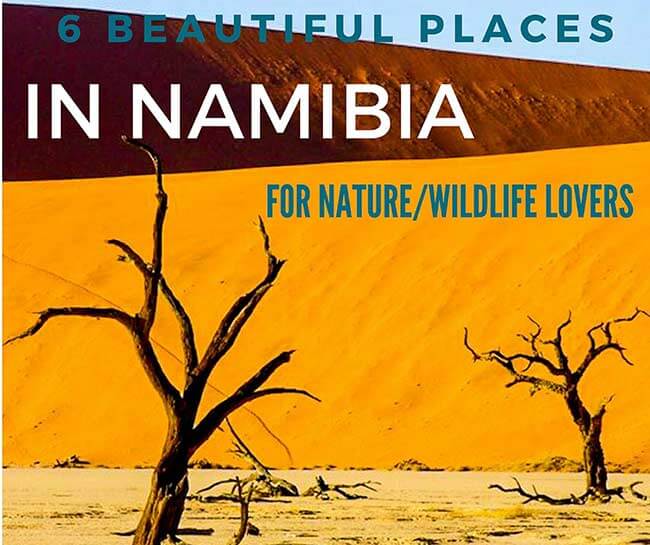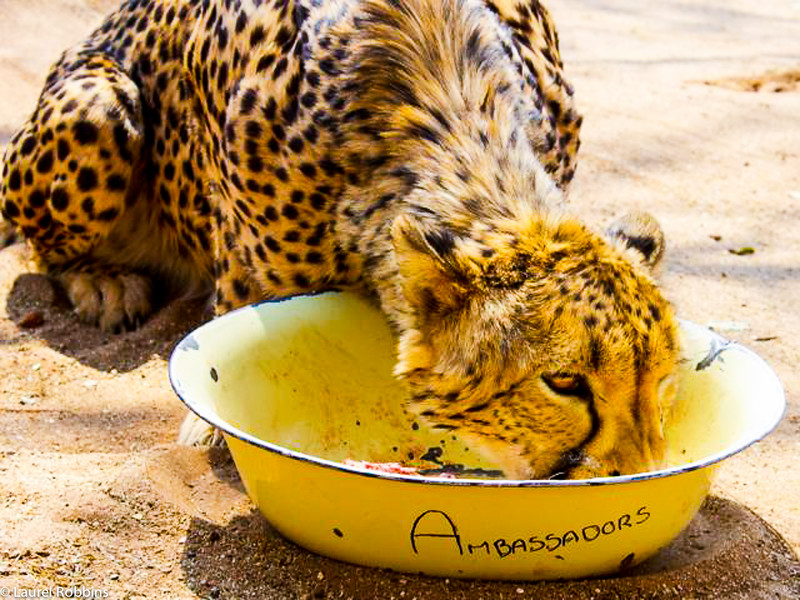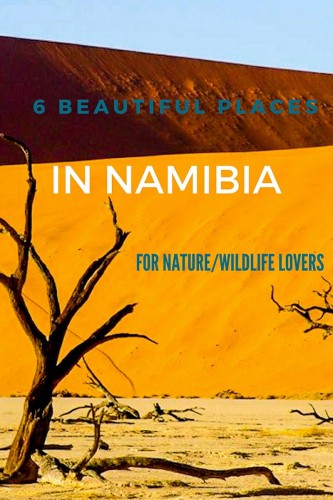The best places to visit in Namibia for nature and wildlife sightings! Namibia is unlike any place I’ve ever been. There’s also a lot of ground to cover!
Table of Contents
Being from Canada, I’m used to vastness. I’m used to driving hundreds of kilometres with only a small village or two along the way. In that way, Namibia reminded me of road trips I’ve done in Canada, except that it’s even more remote! After Mongolia, Namibia is the second least densely populated country in the world!
If it’s solitude that you’re seeking, you can’t beat Namibia!
I loved driving hundreds of kilometres and not seeing a single soul. I didn’t keep track, but I’m sure that I saw more wildlife than people! Where people aren’t wildlife is! It’s a rather beautiful thing!
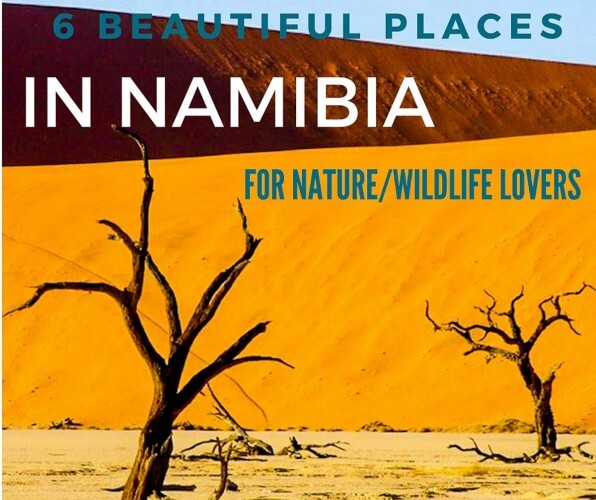
The Kalahari Desert in Namibia
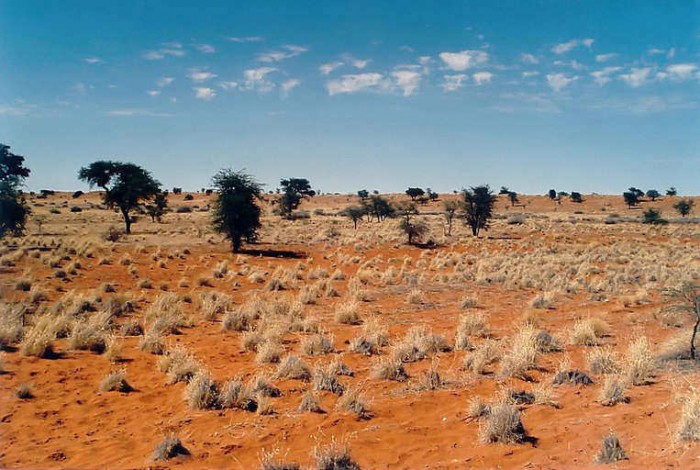
The Kalahari Desert is a bit misleading. While it’s technically a desert, it also houses highly localized environments – some of which are non-deserts!
One of the best examples is the Succulentlent Karoo. Here you’ll find an incredible 5000 different plant species. Half of which are endemic to Namibia! In addition, there is too much plant coverage for a typical desert. You’ll see what I
In addition, there is too much plant coverage for a typical desert. You’ll see what I mean when we get to the Namib Desert in a bit!
Fish River Canyon
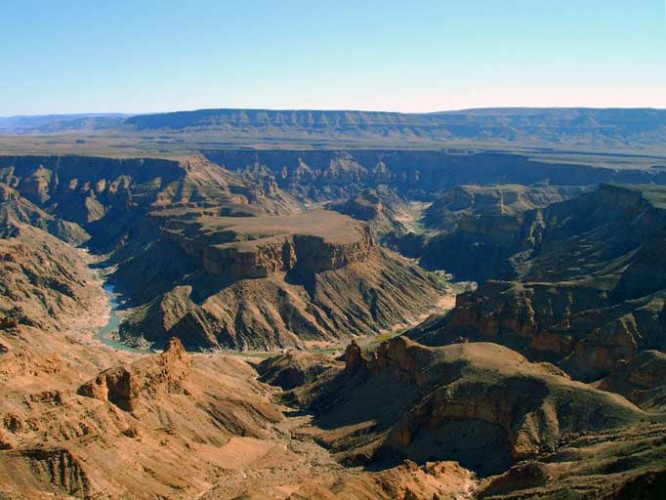
Fish River Canyon is the largest canyon in Africa and the second largest in the world! It’s 160km long, 27km wide in some places and up to 550m deep! It’s no wonder its ruggedness makes it the second most popular tourist attraction in Namibia.
I really regret not visiting Fish River Canyon on my visit to Namibia, but I wouldn’t make that mistake again if I visited. You can spend a day hiking along the rim, or go into the canyon for a real adventure!
It’s no wonder its ruggedness makes it the second most popular tourist attraction in Namibia. I really regret not visiting Fish River Canyon on my visit to Namibia. I wouldn’t make that mistake again if I visited. You can spend a day hiking along the rim, or go into the canyon for a real adventure!
Or if adventure is really calling, consider trekking the Fish River Canyon Hiking Trail. It’s one of the most popular hiking trails in all of southern Africa. It’s a 90km long, 5-day hike.
There are no amenities along the way and there’s no cell phone service in the canyon. There are only 2 emergency stations along the way. In other words, it’s hardcore….and calling my name! Who wants to join me?
Sossusvlei
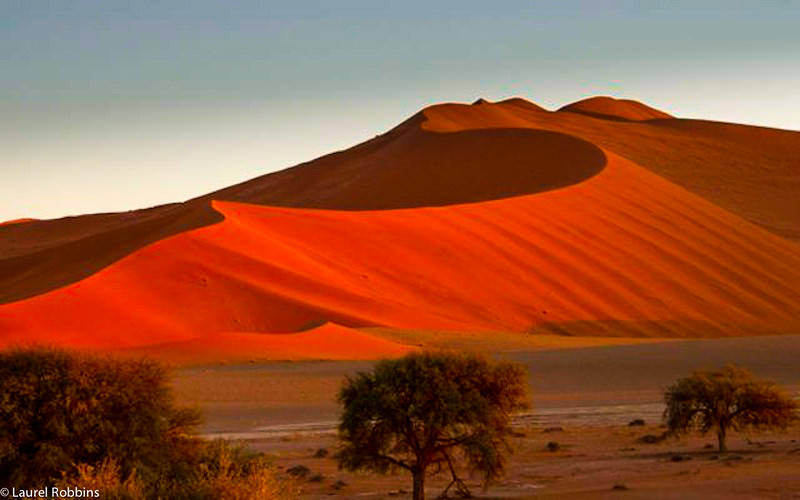
It’s hard to think of a more spectacular sunrise than the one at Sossusvlei – or so I’m told. No, I wasn’t too lazy. I did get up in the wee hours of the morning. When it was still dark to get that photo that everyone gets when they go to Namibia.
You know, the one of the sunrise peering over some of the highest sand dunes in the world, illuminating the sand? I didn’t get that because my driver slept in. He was 45 minutes late picking me up. You can’t make that stuff up!
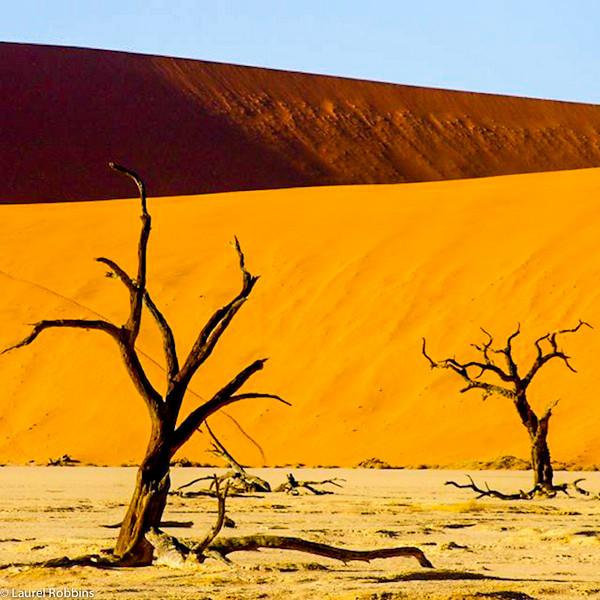
But still, you gotta admit the consolation prize of being there in the morning light was still pretty spectacular! I was adamant that I was going to climb Big Daddy, the most famous of the dunes. It stands at 380 m – give or take. Sand dunes are always a work in process, literally changing form with the wind.
Due to our now behind schedule, we decided to climb one of the 200 m ones instead. I was initially disappointed. I climb 1000 m mountains most weekends!
And then I took my first step. I watched as my leg sank mid-calf, on what first appeared to be hard-packed sand. It’s a slog. You lift each foot up weighted in the sand, only to have it sink into more sand.
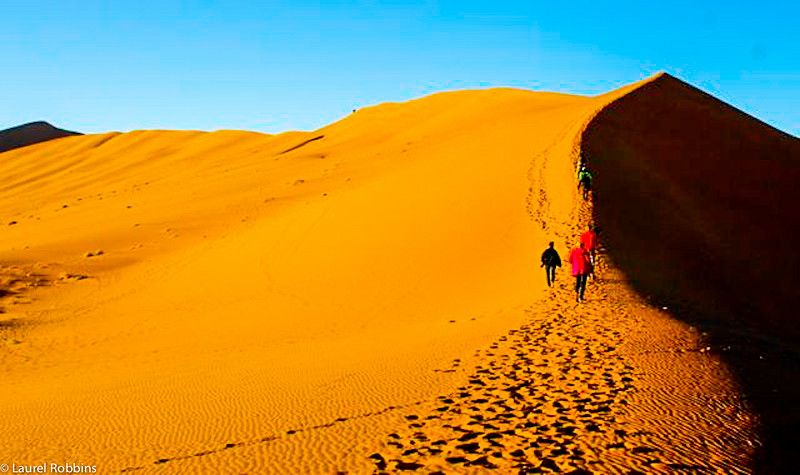
Halfway up I wondered if I was going to make it up this puny 200 m sand dune. As I stopped to catch my breath both legs sank mid-calf into the sand. I did make it up, huffing and puffing. But at the same time, loving every second of it!
Hiking up sand dunes is similar to hiking in snow – without snowshoes. It’s great fun, but it will leave you breathless!
Click here for more photos of Sossusvlei.
You’ll also want to visit the Namib Sand Sea. It’s a UNESCO World Heritage Site and gets its significance from being the only coastal desert in the world where dunes are influenced by fog. It lies within Namibia’s Namib-Naukluft Park.
Swakopmund
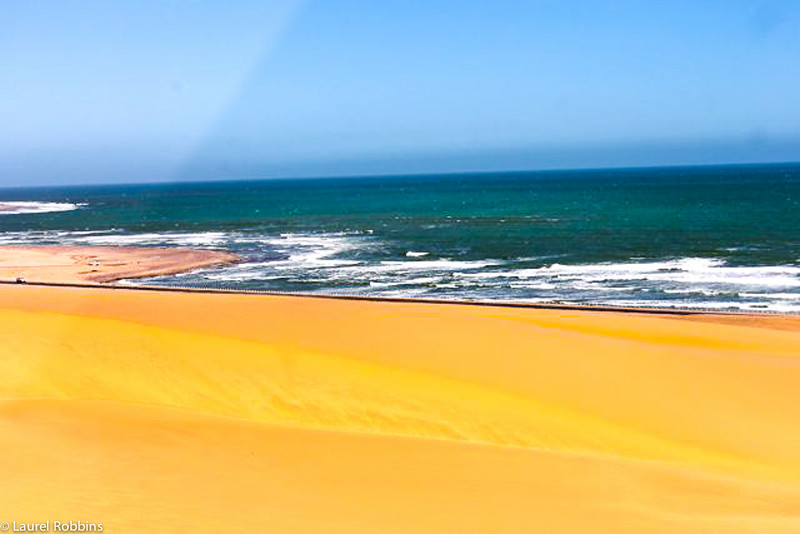
Swakopmund is the fourth largest city in Namibia with ~45,000 residents. It’s a beach resort in the Namib desert, the oldest desert in the world!
Its sand and sea – well the Atlantic ocean, make it popular with Namibian tourists as well. It’s one of the few places in Namibia where you can find cute cafes, so take advantage of a couple of days here. Dolphin cruises are popular, as is sand boarding!
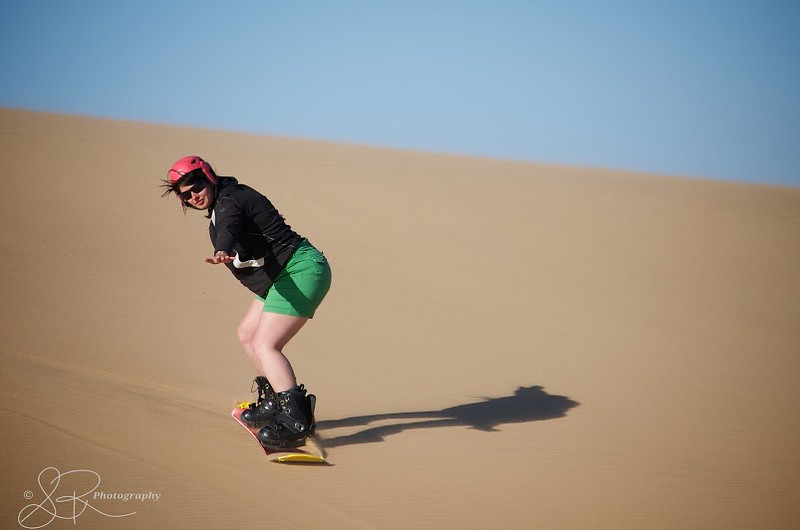
I was SO excited to try sandboarding, even if it involved climbing more sand dunes. In fact, I welcomed the exercise!
As I sank mid-calf each step, I refocused my attention on imagining myself whizzing down a dune on my first try! I’m pretty athletic, this was going to be a piece of cake! Except that it wasn’t!
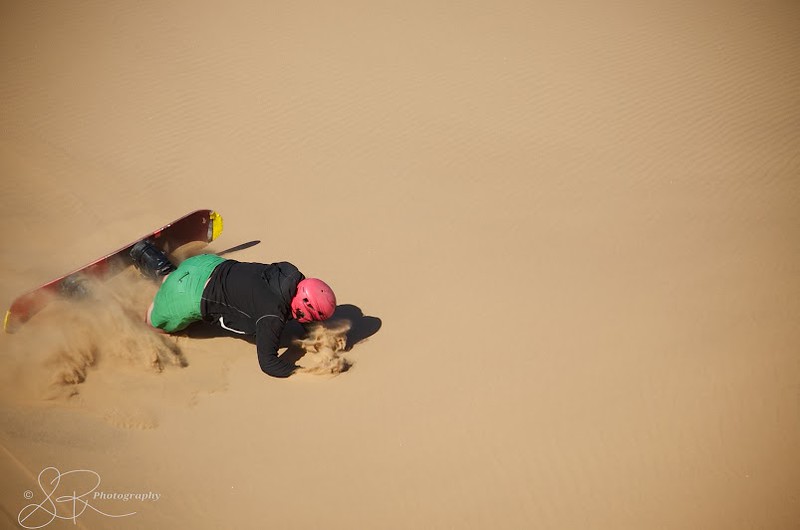
I was terrible. I mean really, really terrible. Despite my stubborn nature and too many attempts to count, the longest I remained standing without falling was maybe 10 seconds. I literally ate sand, which a week later I was still flossing out from my teeth. Did I enjoy sandboarding?
I literally ate sand, which a week later I was still flossing out from my teeth. Did I enjoy sandboarding?
Not one bit, but I’m really glad that I tried it. But what I did enjoy was sledding face first down the dunes. It requires no skill whatsoever, unlike sandboarding. Just remember to keep your mouth closed. Unless you’re hungry for sand!
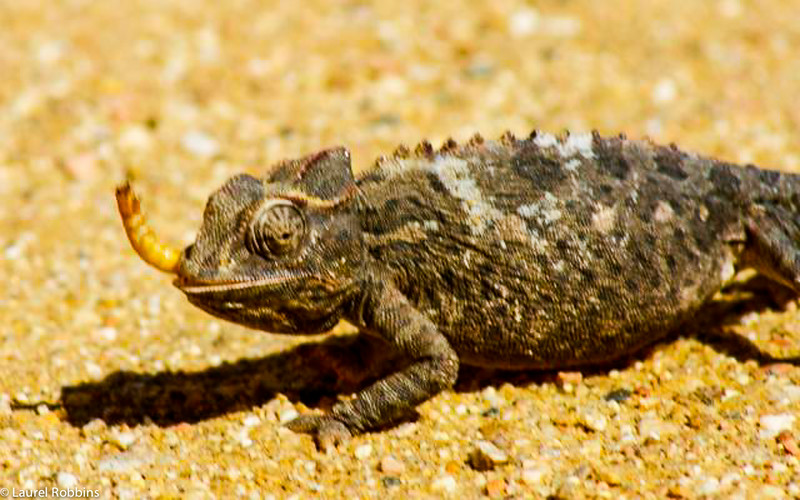
The other highlight that I highly recommend when you’re in Swakopmund is the Living Desert Adventures Tour. It’s easy to see look at the desert and see nothingness. To assume that no species, except for the most desolate would live there, but you’d be wrong.
There are a lot of little critters. If you know where to look. Their adaptations are truly incredible! Life in the Namib Desert isn’t an easy one, but these critters have adapted rather nicely with temperature controls. Wouldn’t you like to have built-in air conditioning be nice? Along with camouflage and other adaptations.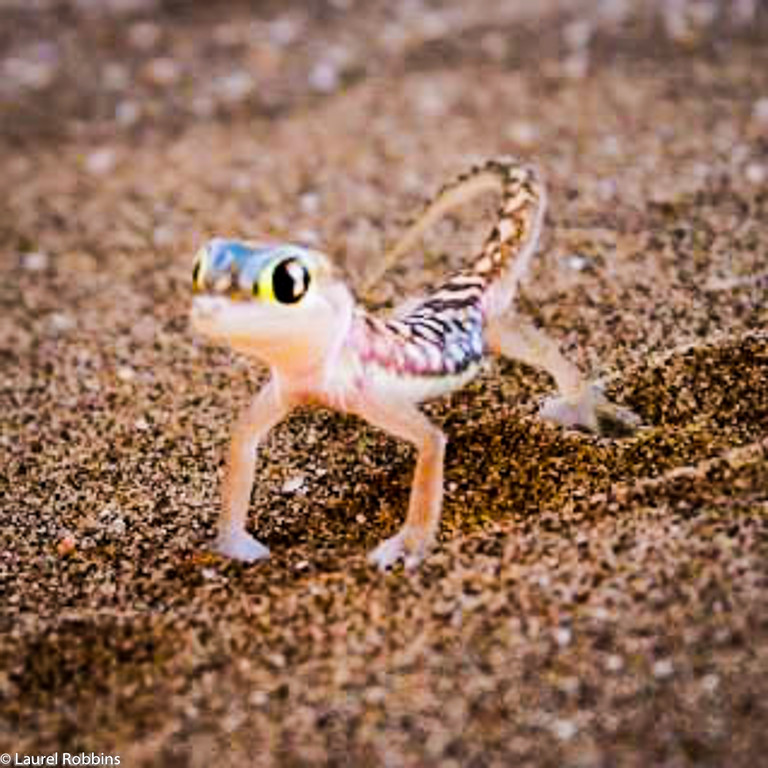
Besides, it’s not just the little guys, you’ll find in the Namib Desert, you can also see desert elephants if you’re really lucky!
Damaraland
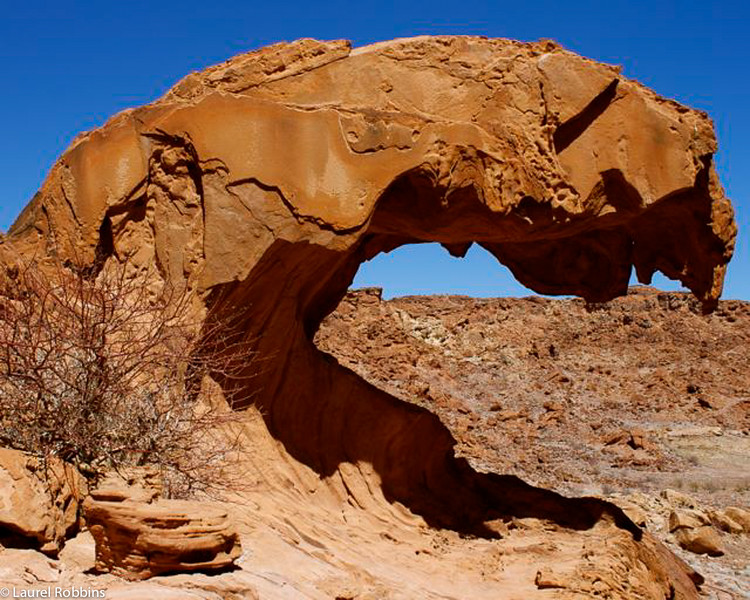
Not to be missed is Namibia’s other UNESCO World Heritage Site, Twyfelfontein. Here you’ll find one of the largest petroglyphs/rock engravings in all of Africa! The drawing
The drawings are in red ochre. They span at least 2000 years and illustrate the hunter-gather lifestyle! It’s a cool place to spend a couple of hours exploring.
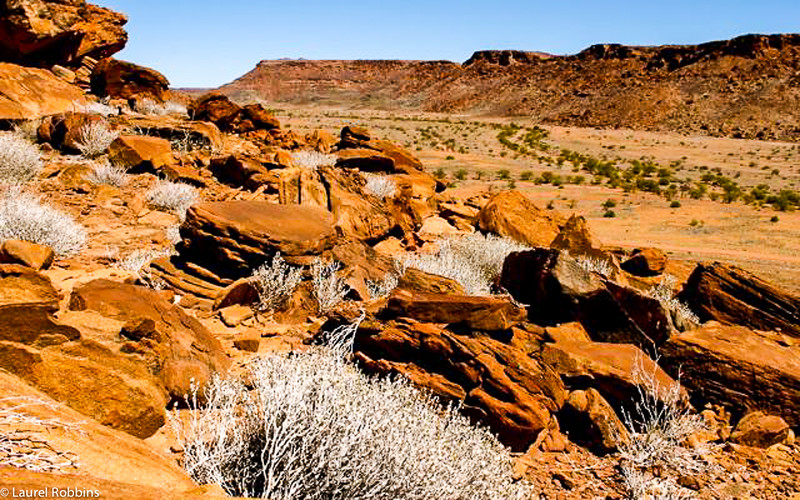
One of the highlights of my entire trip to Namibia was exploring the Klip River Valley in Damaraland. This northwest corner of Namibia is remote and receives much fewer tourists than Etosha.
The lodge I stayed at overlooked the expansive Klip River Valley with an infinity pool. We were warned to be careful when we woke up and made our way from our huts to the main building for breakfast since a leopard had taken to sleeping by the pool!
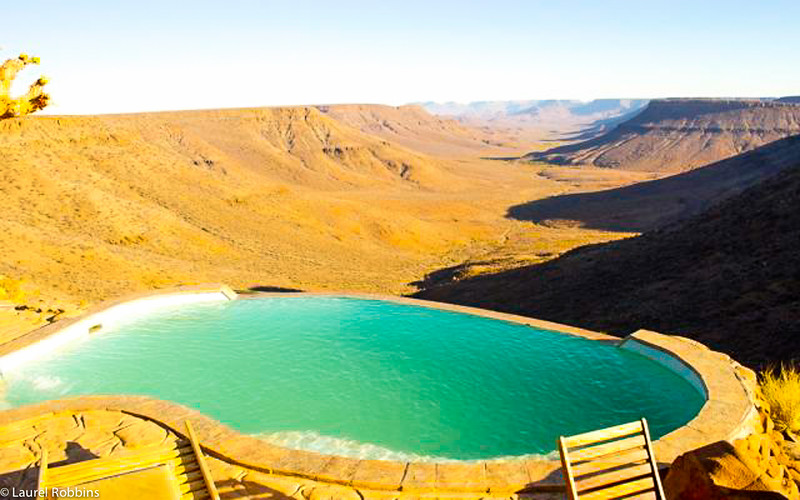
So when at 10:00 at night, I heard someone frantically running towards my hut yelling, Laurel, Laurel, come quick. My heart almost stopped. Who had gotten attacked by the leopard? And, gulp….what was I going to do about it?
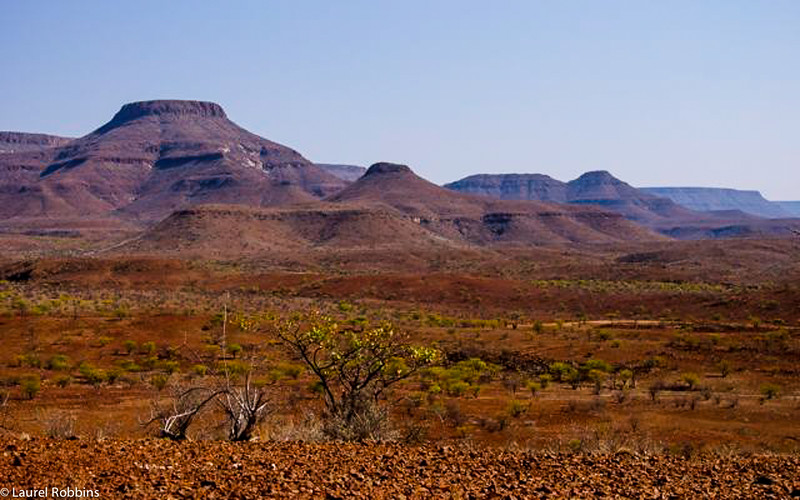
Fortunately, my superpowers of fending off a leopard were not required. Instead, 2 lions had just made a fresh kill on the road. Just a few kilometres away.
Would I like to see it? Hell ya, I’ like to see it. Still wearing my pyjama bottoms and throwing on a coat, we climbed into the 4×4 jeep.
A few kilometres later, we saw the telltale stripes of a zebra lying lifeless on the road. A second later, a lioness peered up from over the carcass.
Her face was covered in blood as she wiped it with her huge tongue. We sat for an hour watching three lionesses and one lion enjoy their kill. Truly an incredible experience!
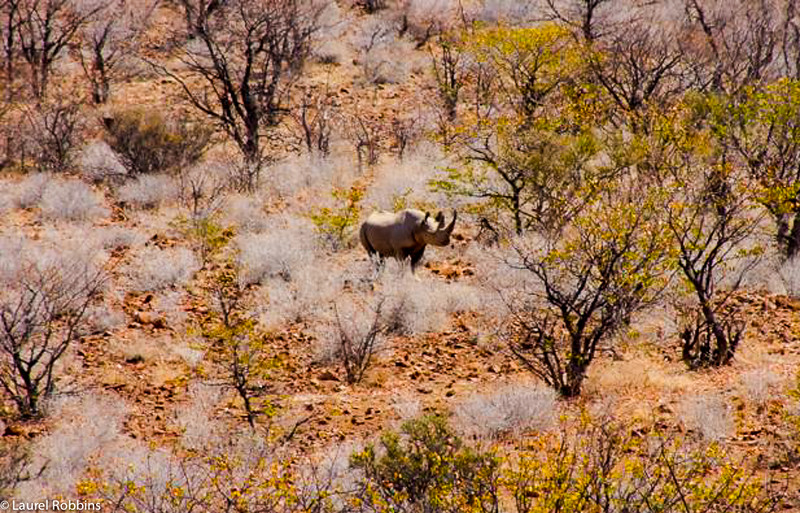
Damaraland also offers one of the coolest things I’ve ever done in my life. Tracking the highly endangered black rhino – on foot! You start off in a 4×4 as the guide looks for telltale signs of the rhino. Then you get out and silently follow the guide who is looking for signs of the rhino. And making sure that you’re upwind.
While all rhinos are herbivores, they have terrible eyesight. They do have an excellent sense of smell though and will charge at anything that they may perceive as a threat. That includes you!
We walked for about an hour. Our guide showing us signs that a black rhino was definitely in the area. Then suddenly, our soft-spoken guide told us to stop and wait for him.
He silently crept over a small hill. Then he waved us to come, putting a finger to his mouth. We were to be absolutely silent.
He had spotted a black rhino in the thicket. It took me several minutes to see him, even with the guide pointing him out. Then I saw movement in the thicket.
The rhino was slowing coming out of hiding! He seemed to know we were there, sniffing in our direction. But fortunately, he made no attempt to close the 50 m gap or so between us! Although it wasn’t safe to come closer, it was one of the coolest wildlife experiences I’ve ever had in my life!
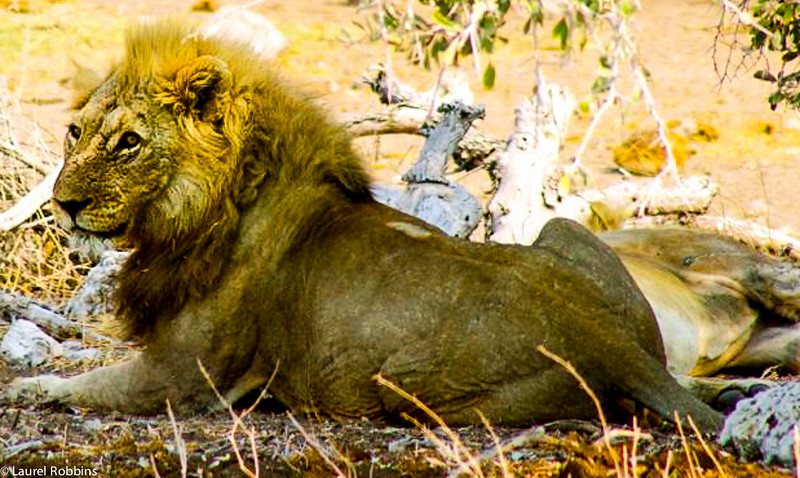
On the way back, safely in the 4×4, we saw a lion and two lionesses lounging under the shade of a large tree. As we stopped to observe them, it dawned on me that we could have run into lions while hiking.
My guide confirmed this. But you have a gun, right? I asked. Nope. I have a stick! If that’s not an adventure, I don’t know what is! But I would do it again in a
But I would do it again in a heartbeat!
You can also visit the Himba people. They are a semi-nomadic tribe living in the northwest region of Kunene, also referred to as Kaokoland in Namibia. This region only has a population density of one person per every 2 square kilometres.
As a result of their isolation and secluded lifestyle they still hold to their culture and traditional way of life. I had very mixed feelings about the impact travellers visits have on the lifestyle of the Himba people.
But one thing I know for sure is that the Himba women have the most incredible hair I’ve ever seen!
Etosha National Park: Namibia’s Greatest Wildlife Sanctuary
Etosha is Namibia’s greatest wildlife sanctuary and an unlikely one at that. Much of it is a large salt pan, so large that it can be seen from space!
This works in wildlife lovers favour though. In winter (June – August), wildlife congregates at the waterholes, virtually guaranteeing wildlife sightings!
I saw several hundred elephants while in Etosha, many of them at the waterholes. They’re some of the largest elephants in all of Africa due to the vitamin and
I saw several hundred elephants while in Etosha, many of them at the waterholes. They’re some of the largest elephants in all of Africa due to the vitamin and nutrient-rich soil.
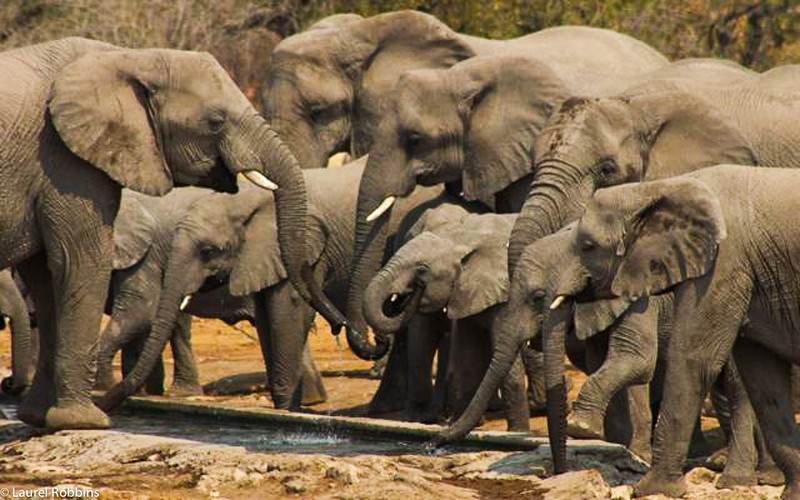
Besides elephants, you can also spot black rhinos, leopards, cheetahs and 340 bird species!
If your main purpose for going to Etosha is to spot wildlife, June – August is the best time to go. During the rainy seasons, you’re likely to see more newborns.
But you’ll have to drive further and search harder. The elephants aren’t as likely then congregate among the waterholes. As they’re a dangerous place.
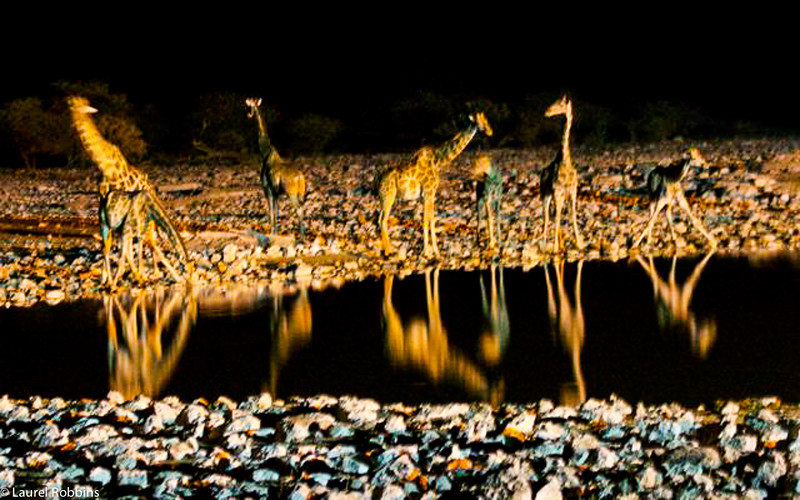
The lodge that we stayed in was one of my favourite lodges of all time. There is a waterhole right in front where the above photo was taken. It’s surrounded by a high wall on one side so that guests can safely observe the happenings.
I stayed there for hours, watching as the giraffes observed who was already there for at least 20 minutes, before making their way there for a drink.
I stayed there for hours. It was fascinating watching the giraffes observe who was already there for at least 20 minutes. Then, they made their way to the waterhole for a drink.
Giraffes are in particular danger when they’re drinking. They’re in a vulnerable position with their heads down and make an easy kill for predators. Every hour or so the inhabitants of the waterhole would rotate as if nature had its own clock!
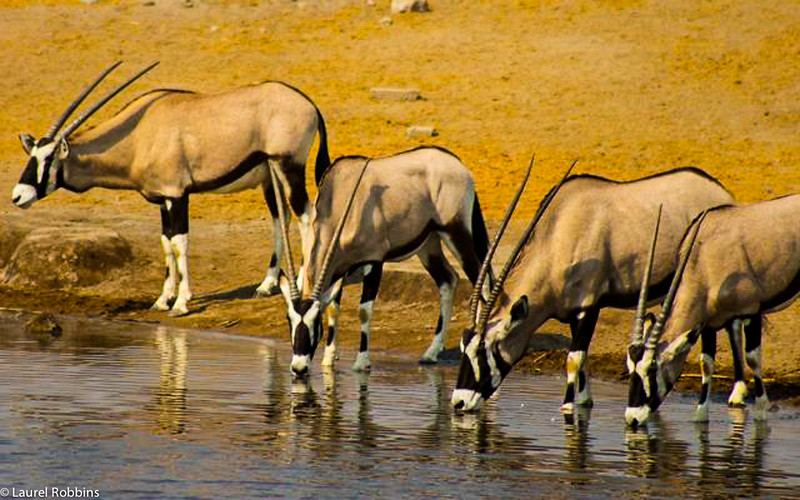
Cheetahs: Namibia is the Cheetah Capital of the World
Namibia is the cheetah capital of the world with 3000! The fastest animal on the planet can reach speeds of up to 113km/hour. The Cheetah Conservation Fund is open every day of the year, except Christmas.
They offer a range of activities from educational presentations and feedings to cheetah runs where you can see them in action! Check their schedule in advance to make the most of your visit. I was lucky enough to get to feed them!
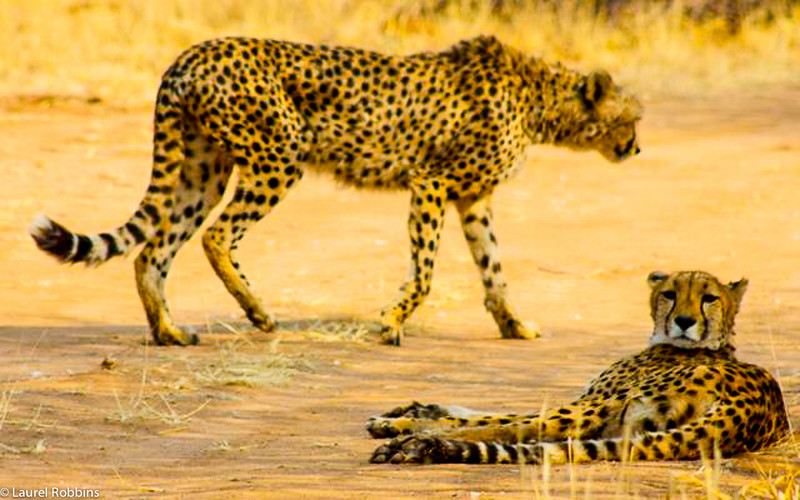
Know Before You Go to Namibia:
Be prepared for a lot of driving.
Namibia is a huge country and distances are vast! You should also know how to change a flat tire. Roads are in varying conditions depending on where you’re going. If you’re trying to reduce some of the driving, the easiest would be to (sadly) omit Fish River Canyon which is 571 km away (8
If you’re trying to reduce some of the driving, the easiest would be to (sadly) omit Fish River Canyon as it’s 571 km (8 hours + drive) from Sossusvlei. This is why I didn’t visit it on my first visit.
Book far in advance.
Despite only having 1 million tourists each year, many of those tourists visit the same places where there are very limited accommodations, like in Etosha. When I was there in August, the manager of the property I was staying at said they were already 60% booked out for the following August.
I personally blame it on the Germans ;). Namibia is a popular holiday destination for them, being a former German colony, and Germans like to plan holidays out far in advance.
I personally blame it on the Germans ;). Namibia is a popular holiday destination for them, being a former German colony, and Germans like to plan holidays out far in advance.
Where is Namibia exactly?
Namibia is on the west coast in southern Africa. Its western border meets the Atlantic Ocean. You can see a map of Namibia below.
What’s the population of Namibia?
2.1 million. It’s the second least densely populated country in the world after Mongolia.
What’s the weather like in Namibia?
Many areas receive more than 300 days of sun! Winter is from June to August. I was there in August and was still wearing shorts, but it does cool down in the evening and first thing in the morning.
There are two rainy seasons. The one from September to November where there’s not as much rain, and the main one from February to April.
What language do they speak in Namibia?
Until 1990, English, German and Afrikaans were the official languages. Now, the most common language is Oshiwambo, spoken by 49% of the population. The most widely understood language is Afrikaans.
Need more convincing to visit Namiba?
Here are 11 reasons why Namibia is awesome!
